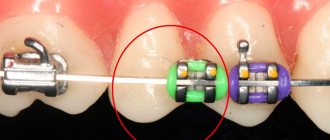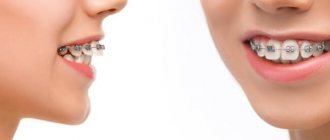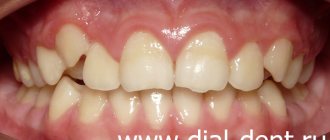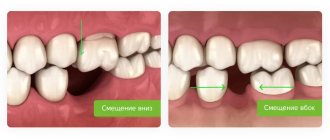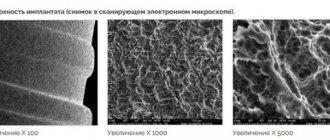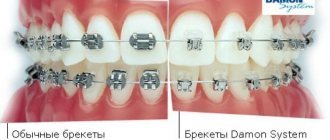Bite correction is carried out not only for teenage children, but also for adults. Metal systems used for the correction of orthodontic anomalies are also actively used, especially in cases of severe disturbances in the functioning of the dentofacial apparatus, in which it is necessary to exert pronounced pressure on the teeth.
In our family dentistry, you can get braces and begin effective treatment of dental anomalies. Throughout the entire period of correction, it is necessary to visit the orthodontist and carefully monitor oral hygiene. The doctor will help you choose braces for your teeth and advise you on how to care for them.
What is a braces system?
Braces are a non-removable orthodontic structure that is attached to the teeth and is intended to correct congenital and acquired occlusion defects. The system consists of several components:
- bracket plates fixed with an adhesive mixture on the surface of the tooth enamel;
- a power arc that creates mechanical pressure on the teeth and forces them to gradually move in a given direction. The arch is attached to each bracket plate either using miniature locks or using ligatures (wires or rubber bands).
The process of movement of dental elements is determined by the ability of bone tissue to dissolve in the direction of the vector of movement of the dental element (resorption) and regenerate in the place from which the tooth has moved. Thus, it turns out that the dental unit, under the influence of a directed force, gradually shifts from its old place to a new one. What causes the movement? An orthodontic arch is made of a metal alloy that has shape memory. This means that the bent arc element tends to straighten to its previous position. And since it is fixed to the tooth enamel, when it straightens, it pulls the teeth along with it.
Analogs
Self-ligating braces Daimon Ku have analogues with similar characteristics:
- H4 is a self-ligating metal system with compact dimensions and low profile. Smooth contours and rounded edges ensure comfortable wearing and prevent caries.
- Victory Series Active SL are non-ligature metal braces created taking into account the wishes of orthodontists. Easy installation and attractive design, excellent results and reliability of the system have made it popular in dentistry.
The manufacturer Omrco also offers other types of braces:
- Damon 3 – vestibular self-ligating ceramic braces, the first aesthetic model of the Damon series. The principle of passive self-ligation allows you to correct problems painlessly with the help of minor efforts of the facial muscles.
- Damon Clear and Damon Clear 2 are vestibular self-ligating ceramic braces, characterized by a complex structure and expensive materials, which is reflected in their cost. The product holds firmly on the teeth and has an aesthetic appearance.
- Inspire ICE – vestibular sapphire ligature braces for anyone who wants to look beautiful despite treatment. They are 100% pigmentation resistant. Meet the requirements of modern dentistry.
- STB – low-profile lingual metal braces with reduced staples. Thanks to this, treatment with the system is carried out comfortably and painlessly, with a high degree of efficiency.
- Mini Diamond – vestibular ligature metal braces of compact size. Convenience and aesthetics complement the fast treatment time compared to classic braces.
Indications for treatment with braces, absolute and relative contraindications
Correction of occlusion is a treatment and is therefore prescribed by an orthodontist only for medical reasons. But even if they exist, not all patients can correct their bite using braces. There are a number of contraindications, which are divided into two subtypes:
- absolute – indicate an unconditional prohibition;
- relative - imply that if the cause of the prohibition is eliminated, correction can be carried out.
Indications for the use of bracket systems:
- Incorrect or incomplete closure of the dentition;
- Interdental spaces
- Crowding of dental elements
- Jaw injuries
- Preparation for prosthetics in the presence of deformities after tooth extraction
Absolute contraindications:
- Severe cardiovascular or endocrine diseases
- Oncology
- HIV AIDS
- Tuberculosis
- Bone and blood diseases
- Mental instability
- Missing teeth to support braces
Relative contraindications:
- Periodontal disease and other periodontal diseases
- Dental diseases
- Alcohol addiction
- Pregnancy
- Any disease in the acute phase
The process of installing braces
You need to make an appointment with an orthodontist at Faceline Clinic. After the examination, the doctor will suggest the best option for orthodontic instruments and name the price for installing braces with turnkey treatment.
The diagnostic and planning stage is especially important. You will need a panoramic image of the jaws, a computed tomography scan, a photo protocol, and impressions of the dentition. Based on these data, the laboratory produces a system specifically for your clinical case.
Sanitation of the oral cavity (ultrasonic cleaning, enamel polishing and remineralization) is mandatory.
The installation itself takes on average 1 hour. The orthodontist firmly attaches each bracket to the outer surface of the tooth with an adhesive compound and connects the retainers with an orthodontic archwire.
In the future, you will need to visit the orthodontist once every month to month and a half to monitor treatment and correct the arch. Don’t forget to make an appointment every 2-3 months for professional hygiene to clean your braces and teeth from plaque.
Consequences of lack of treatment
Minor defects of the dentofacial apparatus do not have any significant significance for human health. This can only cause emotional dissatisfaction with your appearance. More serious pathologies require mandatory treatment. If the existing anomaly is not corrected, a number of serious health problems are inevitable:
- increased abrasion of tooth enamel;
- diseases of teeth and gums;
- permanent injury to periodontal tissues;
- slurred diction;
- poor chewing of food;
- diseases of the gastrointestinal tract;
- temporofacial joint deformity;
- frequent headaches.
Experts advise: you should not put off treatment “for later”; the sooner it is started, the sooner it will end. If you are unsure whether your child has orthodontic problems, make an appointment with a dental clinic. The doctor will determine the presence of indications and advise the best way to eliminate the defect.
Features of the Damon Q bracket system
The design of the braces of the brand in question is similar to that of other vestibular metal non-ligature orthodontic systems. But it still has its own distinctive features:
- miniaturization and roundness of all edges. This makes the product more aesthetically pleasing and less traumatic for the mucous membranes of the lips and cheeks;
- the streamlined shape of the braces facilitates their hygienic care;
- convenient way to open the fastening cover. This makes the dentist’s work on setting up the system more efficient;
- reliability of the lock opening mechanism, increasing the strength of the system as a whole;
- extra-fixation on the enamel, ensured by the optimal shape and roughness of the cushion on the base of the braces (patented Ormco technology);
- dimensional accuracy and polished grooves of the power arc, facilitating perfect sliding.
Bracket therapy algorithm
The treatment process consists of several successive stages:
- anamnesis collection, visual examination, diagnostics using computer and radiographic equipment;
- choosing a correction method and type of bracket system, developing a correction plan;
- sanitation of the oral cavity;
- production of braces;
- installation of a corrective system on the patient’s teeth;
- the treatment process itself with periodic adjustment of equipment with mandatory visits to the clinic;
- removing braces when the desired result is achieved;
- wearing retention devices to secure the new position of the teeth.
Important: the choice of the type of braces, the duration of wearing them and the period of use of retention devices is determined by the attending orthodontist, depending on the specific situation. The doctor's recommendations must be followed exactly. Otherwise, you should not expect any effect from correctional therapy.
Damon model line
Various brace systems are produced under the Daimon brand. The line is represented by the following models.
Clear. Invisible ceramic products with the addition of polycrystalline aluminum oxide provide protection against darkening and stains, lightweight fixation and good adhesion to tooth enamel.
Clear
Clear 2. The use of 3D computer modeling allows you to calculate and manufacture braces to correct your bite, taking into account the individual characteristics of the patient’s teeth. Thanks to this, the treatment period is significantly reduced, deterioration of lateral closure and improper movement of teeth is eliminated.
Damon 3. Made from a combination of metal (40%) and ceramic (60%). Due to the provided passive force, it shows high results in occlusion correction. The most accurate calculation of force allows you to achieve a stimulating effect on physiological processes in dental tissue without disrupting blood circulation.
Damon 3
Damon 3 mx. It has an improved fastening mechanism and rounded shapes. In design it is inferior to the Clear model.
Damon 3MX
Of the entire line, the Damon q model has the smallest size and highest strength. Its design uses a “sliding door” lid that does not put pressure on the arc, but only prevents it from slipping out. According to doctors and patients, Dimon q braces are the most convenient to use. Reviews of people who have undergone treatment with their help confirm this fact.
Advantages and disadvantages of Damon Q braces
The advantages of Damon Q braces have been proven by years of successful practice and millions of treated patients around the world. There are some minor disadvantages, but they are completely outweighed by the advantages of this brand.
Advantages:
- high degree of effectiveness in correcting pathologies of any severity;
- no age limit for the patient;
- the miniature size of the locks and the platform on which they are installed;
- the ability to minimize the number of scheduled visits to the orthodontist (every 8-10 weeks);
- maximum physiological impact;
- optimal treatment period.
Flaws:
- visibility to prying eyes;
- possible allergic reactions;
- limiting the consumption of hard and sticky foods.
Flaws
Most dentists who have experience correcting bites using the Damon Q braces system have not found any significant shortcomings in it.
In their opinion, the effectiveness of using this design directly depends on the individual structural features of the human dentition and the complexity of the existing pathology.
The only drawback of the system that patients note is its high cost, however, in their opinion, this point is compensated by the result from using the design.
Hygienic care
During the course of correction, it is necessary to carefully observe oral hygiene. This is due to the fact that a large number of pathogenic microorganisms accumulate on the elements of the orthodontic structure. If they are not removed in a timely manner, the teeth may begin to decay.
Dentists advise:
- Clean your mouth twice a day and after every meal. If it is impossible to clean your mouth, you should rinse your mouth thoroughly;
- use special devices for cleaning: v-shaped toothbrushes, brushes for braces, dental floss, irrigator (a device that cleans teeth with a stream of water under pressure);
- exclude seeds, nuts, dried fruits, toffees, marshmallows, candies, etc. from the diet;
- Use hard foods exclusively in grated or finely chopped form.
